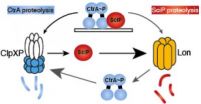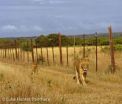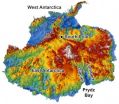(Press-News.org) AMHERST, Mass. – Biochemists at the University of Massachusetts Amherst including assistant professor Peter Chien recently gained new insight into how protein synthesis and degradation help to regulate the delicate ballet of cell division. In particular, they reveal how two proteins shelter each other in "mutually assured cleanup" to insure that division goes smoothly and safely.
Cells must routinely dispose of leftover proteins with the aid of proteases that cut up and recycle used proteins. The problem for biochemists is that the same protein molecule can be toxic garbage at one time, but essential for function at another time such as during the cell cycle, that is, events that unfold to achieve replication of chromosomes and division of the cell.
As Chien explains, "We know that a process that has to happen as reliably and stably as cell division also has to be flexible enough to allow the organism to grow and respond to its ever-changing environment. We're interested in uncovering all the steps and back-up safeguards that cells use to robustly protect replication while at the same time allowing other functions to proceed." Results appear in the early online edition of Molecular Microbiology.
To do this work, Amber Cantin in Chien's lab, closely collaborated with Michael Laub and colleagues at MIT to look in a bacteria, Caulobacter, where they had previously figured out how cells distinguish waste proteins from useful molecules. They focused on a protein called CtrA that sits on DNA like a cap, controlling replication until conditions are right for division to occur.
Destruction of CtrA allows cells to start replicating their chromosome. Cantin used biochemical experiments with highly purified proteins to show that CtrA was only degraded when it was bound to DNA and that another protein, SciP, could help make CtrA bind better to DNA, making CtrA more resistant to proteolysis.
Surprisingly, this also made SciP less able to be destroyed as well, showing that both proteins prevent their own destruction by protecting each other. In addition, while both proteins were destroyed, they were recognized by completely different proteases. These advances, along with current findings, may offer medical researchers a clue for understanding diseases such as abnormal cell cycle progression in cancer.
INFORMATION:
This work was funded by a grant from the National Institutes of Health and additional funds from UMass Amherst.
New insight into double-protected dance of cell division
2013-03-06
ELSE PRESS RELEASES FROM THIS DATE:
New report confirms almost half of Africa's lions facing extinction
2013-03-06
A new report published today concludes that nearly half of Africa's wild lion populations may decline to near extinction over the next 20-40 years without urgent conservation measures. The plight of many lion populations is so bleak, the report concludes that fencing them in - and fencing humans out - may be their only hope for survival.
Led by the University of Minnesota's Professor Craig Packer and co-authored by a large team of lion biologists, including Panthera's President, Dr. Luke Hunter, and Lion Program Director, Dr. Guy Balme, the report, entitled Conserving ...
Assembling the transcriptome of a noxious weed: New resources for studying how plants invade
2013-03-06
In order to build and maintain cells, DNA is copied into ribonucleic acid (RNA) molecules, also called transcripts. Transcripts are often like a recipe for making proteins, and a collection of all the transcripts in a cell is called a transcriptome.
Pankaj Jaiswal, Assistant Professor of Botany and Plant Pathology at Oregon State University, Samuel Fox, a Postdoctoral Associate in Jaiswal's laboratory, and colleagues assembled transcriptomes of a noxious weed, Brachypodium sylvaticum, or slender false brome. The transcriptome provides an extensive genetic tool for studying ...
The making of Antarctica's hidden fjords
2013-03-06
Antarctica's topography began changing from flat to fjord-filled starting about 34 million years ago, according to a new report from a University of Arizona-led team of geoscientists.
Knowing when Antarctica's topography started shifting from a flat landscape to one with glaciers, fjords and mountains is important for modeling how the Antarctic ice sheet affects global climate and sea-level rise.
Although radar surveys have revealed a rugged alpine landscape under Antarctica's two-mile-thick ice sheet, the surveys tell nothing about when the continent's deep valleys ...
Modeling Jupiter and Saturn's possible origins
2013-03-06
Washington, D.C.—New theoretical modeling by Carnegie's Alan Boss provides clues to how the gas giant planets in our solar system—Jupiter and Saturn—might have formed and evolved. His work was published recently by the Astrophysical Journal.
New stars are surrounded by rotating gas disks during the early stages of their lives. Gas giant planets are thought to form in the presence of these disks.
Observations of young stars that still have these gas disks demonstrate that sun-like stars undergo periodic outbursts, lasting about 100 years, which transfer mass from the ...
Focal therapy offers middle ground for some prostate cancer patients
2013-03-06
Men with low-risk prostate cancer who previously had to choose between aggressive treatment, with the potential for significant side effects, and active surveillance, with the risk of disease progression, may have a new option. Focal laser ablation uses precisely targeted heat, delivered through a small insertion and guided into the prostate by magnetic resonance imaging, to burn away cancerous cells in the prostate.
A small, phase 1 trial, to published early online in the journal Radiology, found that this approach, designed to treat just the diseased portion of the ...
Spinal tap -- using cactus spines to isolate DNA
2013-03-06
Isolation of DNA from some organisms is a routine procedure. For example, you can buy a kit at your local pharmacy or grocery store that allows you to swab the inside of your cheek and send the sample for DNA sequencing. However, for other organisms, DNA extraction is much more problematic. Researchers at Desert Botanical Garden in Phoenix, Arizona, have developed a novel procedure that greatly simplifies genomic DNA isolation from cactus tissue.
For members of the family Cactaceae, isolation of genetic material can be difficult due to the presence of polysaccharide-based ...
Temple researchers discover key to heart failure, new therapies on horizon
2013-03-06
(Philadelphia, PA) – Some 5.8 million Americans suffer from heart failure, a currently incurable disease. But scientists at Temple University School of Medicine's (TUSM) Center for Translational Medicine have discovered a key biochemical step underlying the condition that could aid the development of new drugs to treat and possibly prevent it.
"Drugs we currently use for heart failure are not very effective," explained lead investigator Walter J. Koch, PhD, Professor and Chairman of the Department of Pharmacology at TUSM, and Director of the Center for Translational Medicine ...
Biomarkers may help predict progression of Barrett's esophagus to esophageal adenocarcinoma
2013-03-06
PHILADELPHIA — A series of microRNA expression signatures that may help to define progression of the precancerous condition Barrett's esophagus into esophageal adenocarcinoma was reported recently in Cancer Prevention Research, a journal of the American Association for Cancer Research.
"Once a rare cancer representing only 5 percent of all esophageal cancers in the United States, esophageal adenocarcinoma is the cancer with the fastest-rising incidence — six-fold increase in the past three decades — and currently comprises more than 80 percent of all new esophageal cancer ...
Visceral fat causally linked to intestinal cancer
2013-03-06
PHILADELPHIA — Visceral fat, or fat stored deep in the abdominal cavity, is directly linked to an increased risk for colon cancer, according to data from a mouse study published in Cancer Prevention Research, a journal of the American Association for Cancer Research.
"There has been some skepticism as to whether obesity per se is a bona fide cancer risk factor, rather than the habits that fuel it, including a poor diet and a sedentary lifestyle," said Derek M. Huffman, Ph.D., postdoctoral fellow at the Institute for Aging Research at the Albert Einstein College of Medicine ...
CSI: Milky Way
2013-03-06
These days the core of the Milky Way galaxy is a pretty tame place...cosmically speaking. The galactic black hole at the center is a sleeping giant. Existing stars are peacefully circling. Although conditions are favorable, there doesn't even seem to be much new star formation going on.
But there is growing evidence that several million years ago the galactic center was the site of all manner of celestial fireworks. A pair of assistant professors – Kelly Holley-Bockelmann at Vanderbilt and Tamara Bogdanović at Georgia Institute of Technology – have come up with an ...



